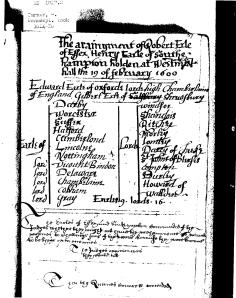One of the big questions about the Shakespeare sonnets is whether they are arranged by the author to create an ongoing chronicle, in the form of a diary of private letters; and the resounding answer of the Monument Theory is … Yes!

A Contemporary Report of the Essex-Southampton trial, showing Edward de Vere as highest-ranking earl on the tribunal
My aim is to demonstrate this answer until, at some point, it becomes self-evident.
The first forty sonnets of the 100-sonnet central sequence are within four chapters of ten sonnets each, covering forty days from the night of the failed Essex Rebellion of February 8, 1601. Oxford is writing to and about Henry Wriothesley, 3rd Earl of Southampton, who remains in his Tower prison room as a convicted traitor who is expected to die by execution:
THE CRIME – sonnets 27-36 – February 8 – 17, 1601
THE TRIAL – sonnets 37-46 – February 18 – 27, 1601
THE PLEA – sonnets 47-56 – February 28 – March 9, 1601
REPRIEVE – sonnets 57-66 – March 10 – 19, 1601

Edward de Vere, Earl of Oxford
CHAPTER THREE – THE PLEA
(Oxford is trying to solidify a “league” or plea bargain with Secretary Robert Cecil on behalf of Southampton, his son by the Queen and her rightful successor by blood. The prince is “locked up” in the Tower while Oxford is desperately putting forth “the lawful reasons” for the Queen to excuse her son and spare his life. [His dealings are actually with Cecil, who needs to bring James of Scotland to the throne upon Elizabeth’s death; otherwise, he will lose all his power and most likely his life.] To that end Oxford visits the Tower and personally tries to persuade Southampton to forfeit any claim as Elizabeth’s natural heir. Oxford’s “grief lies onward” as he rides away from “where thou art” in the prison, while “strange shadows on you tend” — the shadows of disgrace and coming death, during “this sad interim” between the tragedy of the rebellion and whatever the outcome will be.)
Son 47 – Feb 28 – “A League is Took”
Son 48 – Mar 1 – “Locked Up”
Son 49 – Mar 2 – “Lawful Reasons”
Son 50 – Mar 3 – “My Grief Lies Onward”
Son 51 – Mar 4 – “Where Thou Art”
Son 52 – Mar 5 – “Up-Locked”
Son 53 – Mar 6 – “Strange Shadows on You”
Son 54 – Mar 7 – “Sweet Deaths”
Son 55 – Mar 8 – “‘Gainst Death”
Son 56 – Mar 9 – “This Sad Interim”

Tower of London
Has anyone had any other plausible explanation for the torrent of legal terms and “dark” imagery in these sonnets, along with the author’s emotional turmoil and insistence that the beloved younger man is “away” and “locked up”?
The ten sonnets of this chapter are packed with such images and expressions:
“Thy self away … bars [locks, barricades] … my greatest grief … locked up … closure [walls] … to guard the lawful reasons on thy part … the strength of laws … I can allege no cause … tired with my woe … my grief lies onward and my joy behind … excuse … offence … where thou art … excuse … excuse … key … up-locked … imprisoned … millions of strange shadows on you tend … die to themselves … sweet deaths … death and all-oblivious enmity … the ending doom … the judgment … perpetual dullness … this sad interim …”
We’ll take up the story as it proceeds through Sonnets 47-56, with Oxford desperately seeking a [legal] remedy for 27-year-old Southampton before it’s too late. These sonnets reflect the very real suspense that was building and building within 50-year-old Edward de Vere, Earl of Oxford, as he labored behind the scenes and set down this “living record” of his royal son for “the eyes of all posterity that wear this world out to the ending doom.” [Sonnet 55, lines 11-12]
Leave a comment